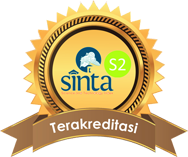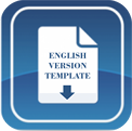THE DEVELOPMENT OF ISLAMIC INTEGRATED BIOCHEMICAL TEACHING MATERIALS USING FOUR STEPS TEACHING METHOD
DOI:
https://doi.org/10.15575/jtk.v5i2.9316Keywords:
biochemistry, enrichment book, Islamic integrated learning, teaching materialAbstract
Islamic-integrated learning is one of the implementations in realizing UIN Syarif Hidayatullah Jakarta’s vision. So, the teaching materials which are integrated with Islamic features are needed. This research aims to develop a biochemistry teaching material in the form of an Islamic-integrated enrichment book specifically on the theory of amino acid and protein that is feasible to be used. The method used in this study is the research and development method through the Four Steps Teaching Material Development (4S-TMD), which consists of selection, structurization, characterization, and reduction. The research data are obtained from the validation of Islamic-integrated chemical study by expert lecturers. The validation result was analyzed using the Guttman Scale, a comprehensive test of concept in the form of the main idea writing test on 60 students of 2016 generation of chemistry education were analyzed by giving a score of 1 for each correct answer, and a score of 0 for wrong answers, and the book's feasibility test in terms of language, presentation, performance, and graphic validated by media expert lecturers, and were analyzed using the Rating Scale. The validation of the Islamic-integrated chemistry shows that all concepts are powerful and worthy of being presented, with the percentage of 91.4%. The comprehensive test of concept shows that all of the concepts have a high level of comprehension. The percentage of students’ comprehensions of all concepts amounted to 92.7%, and all of the concepts are included in the easy category. Therefore there is no need for a reduction phase. Based on the results of the feasibility test of the book, it is obtained the average percentage of 85.5%, which indicates that the Islamic-integrated enrichment book of amino acid and protein material is suitable to be used in the learning of Islamic-integrated biochemistry course to increase student knowledge on biochemical concepts through Islamic aspects which can increase the faith to Allah SWT.
References
Al-Hadabi, A. S. D. (2016). Integrating the Qur ’an Verses into Secondary School Science Curriculum of Yemen : An Islamic Perspective. International Journal of Humanities and Social Science Research, 2, 37–48. Retrieved from http://lifescienceglobal.com/pms/index.php/ijhssr/article/view/3711
Ambarwati, A. (2019). Pengembangan Buku Elektronik Bertema Keberagaman Pangan Pokok untuk Mendukung Gerakan Literasi Di Sma-Smk. Basindo: Jurnal Kajian Bahasa, Sastra Indonesia, dan Pembelajarannya, 3(1), 65–74. http://dx.doi.org/10.17977/um007v3i12019p065
Arifin, A. S. (2016). the Development of Earth Quake Teaching Material for Junior High School By Four Step Teaching Materials Development Method Pengembangan Bahan Ajar Tema Gempa Bumi Menggunakan Four Step Teaching Materials Development. Jurnal Pendidikan Fisika Indonesia, 12(1), 8–18. https://doi.org/10.15294/jpfi
Ashri, N., & Hasanah, L. (2015). Pengembangan Bahan Ajar IPA Terpadu pada Tema Energi dan Lingkungan. Prosiding Simposium Nasional Inovasi dan Pembelajaran Sains 2015 (SNIPS 2015), 469–472. Retrieved from http://portal.fmipa.itb.ac.id/snips2015/files/snips_2015_nurul_ashri_a6ce83ba59dc5806524ae61c520884e1.pdf
Ashri, N., & Hasanah, L. (2016). Uji Keterpahaman dan Kelayakan Bahan Ajar IPA Terpadu. Edusains, 8(2), 145–149. https://doi.org/10.15408/es.v8i2.1818
Batubara, H. H. (2018). Metode dan Model Integrasi Sains dan Islam di Perguruan Tinggi Agama Islam. 1–18. https://doi.org/10.13140/rg.2.2.24112.66563
Chasanah, G., Suryaningsih, S., & Fairusi, D. (2019). Analisis Integrasi Keislaman pada Materi Kimia Pangan (Sumber, Manfaat, dan Keterpahamannya). JTK (Jurnal Tadris Kimiya), 4(2), 168–176. https://doi.org/10.15575/jtk.v4i2.5197
Fauzan. (2017). Integrasi Islam dan Sains dalam Kurikulum Program Studi Pendidikan Guru MI Berbasis KKNI. JMIE (Journal of Madrasah Ibtidaiyah Education), 1(1), 1–13. https://doi.org/10.32934/jmie.v1i1.21
Hendri, S., & Setiawan, W. (2016). the Development of Earth Quake Teaching Material for Junior High School By Four Step Teaching Materials Development Method Pengembangan Bahan Ajar Tema Gempa Bumi Menggunakan Four Step Teaching Materials Development. Jurnal Pendidikan Fisika Indonesia, 12(1), 65–76. https://doi.org/10.15294/jpfi
Jannah, S. W., Saptono, S., & Lisdiana. (2018). Pengembangan Bahan Ajar Sistem Reproduksi Manusia Berwawasan Realigi Sains Untuk Meningkatkan Kemampuan Analisis Siswa MA. Prosiding Seminar Nasional Pendidikan Biologi, 505–511. Retrieved from http://www.jurnalfkip.unram.ac.id/index.php/SemnasBIO/article/view/610
Munawwarah, P., & Anwar, S. (2016). The Development of Interactive E-Book Learning Materials Through 4S TMD. Enriching Quality and Providing Affordable Education Through New Academia, 402–408.
Muslim, B. (2017). Integrating Islamic Perspective in Teaching General Chemistry. 17th Annual International Conference On Islamic Studies, 13.
Muslim, B. (2016). Kimia dalam Perspektif Islam. Islam dan Sains Upaya Pengintegrasian Islam Dan Sains Di Indonesia, 138–149.
Muslim, B., Agung, S., & Al Islam, R. Z. (2017). Chemistry Teacher’s Perception About Integration of Islam and Chemistry. International Conference On Education In Muslim Society, 168–183.
Muslim, B., & Fajriah, S. N. (2017). Pendidikan Islam : Isu dan Inovasi. FITK PRESS.
Muslim, B., Nofianti, R., & Suryaningsih, S. (2020). Supporting Preservice Chemistry Teachers to Learn Islam and Science Using Moodle. Advances in Social Science, Education and Humanities Research, 408(Iconist 2019), 74–80. https://dx.doi.org/10.2991/assehr.k.200220.014
Nugroho, B. T. A. (2017). Integration of Islamic Education with Science and Technology in Islamic Junior High School. Mudarrisa: Jurnal Kajian Pendidikan Islam, 9(1), 1–27. https://doi.org/10.18326/mudarrisa.v9i1.1-27.
Pusat Kurikulum dan Perbukuan. (2014). Pedoman Penulisan Buku Non Teks Pelajaran. Jakarta: Kementrian Pendidikan dan Kebudayaan.
Rahman, D. F., Chandra, D. T., & Anwar, S. (2019). Development of an Integrated Science Teaching Material Oriented Ability to Argue for Junior High School Student. Journal of Physics: Conference Series,1157(2). https://doi.org/10.1088/1742-6596/1157/2/022056
Ramli, M., Muslim, B., & Fajriah, S. N. (2019). Integrasi Pencemaran Logam Berat dan Islam Menggunakan Metode 4-STMD. Jurnal As-Salam, 3(3), 102–115. https://doi.org/10.37249/as-salam.v3i3.141
Riduwan. (2010). Dasar-Dasar Statistika. Bandung: Alfabeta.
Suprayogo, I. (2017). Membangun Integrasi Ilmu dan Agama: Pengalaman UIN Maulana Malik Ibrahim Malang. Batusangkar International Conference, 1(1), 27–46. Retrieved from http://ecampus.iainbatusangkar.ac.id/ojs/index.php/proceedings/article/view/531
Suryaningsih, S., Muslim, B., & Wati, N. A. (2020). Islamic Values in the Use of Four Steps Teaching Material Deveelopment (4-Stmd) Method In Teaching Stoichimetry Material. Journal of Education in Muslim Society, 7(1), 78–87. https://doi.org/10.15408/tjems.v7i1.14066
Syamsuri, B. S., Anwar, S., & Sumarna, O. (2017). Development of Teaching Material Oxidation-Reduction Reactions through Four Steps Teaching Material Development (4S TMD). Journal of Physics: Conference Series, 1–7. https://doi.org/10.1088/1742-6596/895/1/012111
Wahidiyah, Jamaluddin, & M.Yamin. (2018). Pengembangan Bahan Ajar IPA Terpadu Menggunakan Four Steps Teaching Material Development (4s TMD) Pada Pembelajaran Ipa Smp.
Windayani, N., Hasanah, I., & Helsy, I. (2018). Analisis Bahan Ajar Senyawa Karbon Berdasarkan Kriteria Keterhubungan Representasi Kimia. Jurnal Tadris Kimiya, 3(1), 83–93. https://doi.org/10.15575/jtk.v3i1.2682
Yusuf, N. (2011). Perspektif Islam Tentang Pengintegrasian Ilmu Akhlak dalam Pembelajaran Ilmu Sains dan Penerapannya di Lembaga Pendidikan Islam. Jurnal Penelitian Sosial Keagamaan, 14(2), 223–243. Retrieved from http://ejournal.uin-suska.ac.id/index.php/Kutubkhanah/article/view/404
Zain, Z., & Vebrianto, R. (2017). Integrasi Keilmuan Sains dan Islam dalam Proses Pembelajaran Rumpun IPA. Seminar Nasional Teknologi Informasi, Komunikasi Dan Industri (SNTIKI) 9, 18–19.
Downloads
Published
How to Cite
Issue
Section
Citation Check
License
Authors who publish with this journal agree to the following terms:
- Authors retain copyright and grant the journal right of first publication with the work simultaneously licensed under a Creative Commons Attribution-ShareAlike that allows others to share the work with an acknowledgement of the work's authorship and initial publication in this journal.
- Authors are able to enter into separate, additional contractual arrangements for the non-exclusive distribution of the journal's published version of the work (e.g., post it to an institutional repository or publish it in a book), with an acknowledgement of its initial publication in this journal.
- Authors are permitted and encouraged to post their work online (e.g., in institutional repositories or on their website) prior to and during the submission process, as it can lead to productive exchanges, as well as earlier and greater citation of published work (See The Effect of Open Access).








